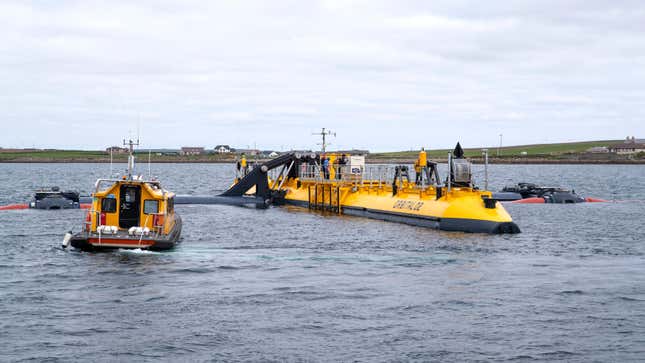
When you hear the word “turbine,” in conversation, chances are good you’re picturing the same sort of giant windmill-esque apparatuses jutting out of the ground, turning wind into good, clean electricity. But there’s a new kind of turbine on the block—tidal turbines that harness the power of the water’s currents to generate electricity. And this week, we’re getting what one company calls the “world’s most powerful tidal turbine” which has begun converting the ocean’s waves into electricity.
That’s according to Orbital Marine Power, a Scottish engineering firm that first launched the 680-metric-ton turbine off the coast of Dundee earlier this year before towing it closer to the European Marine Energy Centre based out of the Orkney Islands in the UK, just north of mainland Scotland. The so-called O2 turbine is currently anchored off the Fall of Warness—a tidal turbine testing site—and connected to a nearby onshore electricity network with the help of some subsea cables.
“Our vision is that this project is the trigger to the harnessing of tidal stream resources around the world to play a role in tackling climate change whilst creating a new, low-carbon industrial sector,” Orbital CEO Andrew Scott said in a statement. CNBC reports that the 243-foot (74-meter) turbine is expected to be churning tides into electricity “for the next 15 years,” and should be capable of meeting the demand of roughly 2,000 homes throughout the UK—and offsetting 2,200 tonnes of carbon dioxide per year.
These current-powered turbines aren’t the only source of alternative energy Scotland’s been harnessing in recent years. As part of the country’s surprisingly fruitful efforts to bring down its greenhouse gas emissions, we’ve seen Scotland create truck fuel from distillery waste and plans for entire net-zero neighborhoods. Meanwhile, the country predicts that it will be adding more than 20,000 jobs over the next decade as it begins building out massive facilities for direct air capture and carbon dioxide removal, two technologies that haven’t been proven at scale but that will almost certainly play some role in efforts to protect the climate.
Scotland has set a number of aggressive climate targets, including meeting 100% of its electricity needs from renewables by last year, a goal it basically hit. More than 70% of that comes from wind turbines. Tidal turbines play a very bit part in comparison, but that may be changing.
As you might expect for a region that’s surrounded by quite a few bodies of water, Scotland has been tinkering with the concept of sea-based turbines for a while. One recent report from the World Economic Forum found that four tidal turbines had generated enough energy to power close to 4,000 homes throughout 2019. Meanwhile, another monster tidal turbine was rolled out last year by Simec Atlantis Energy. The company has plans to install an array of 269 tidal turbines that could crank out enough power for 175,000 homes across Scotland when fully operational. The tech we need to harness tidal power might still be in its infancy when compared to its land-based counterparts, but those numbers are giving us a pretty good reason to give it a shot. The fact that tides are also predictable and regular sources of clean energy adds to the urgency as the world races to electrify everything.
Correction, 7/29/21, 10:15 a.m.: This post has been updated to clarify that the O2 tidal turbine sits in the water, not above it, and that the AR2000 turbine itself will not power 175,000 homes. Rather, an array of them will. We regret the errors. Additional context has also been added for greater clarity.